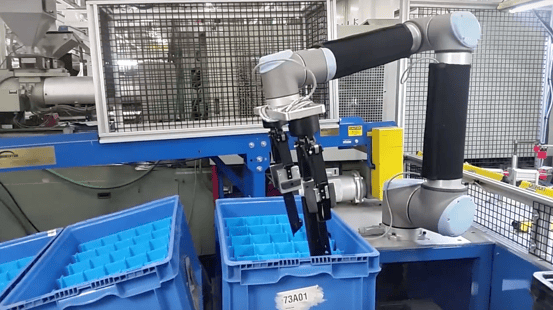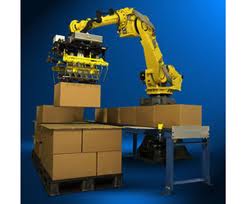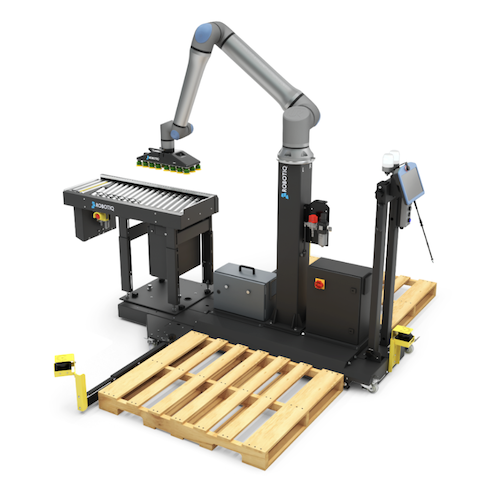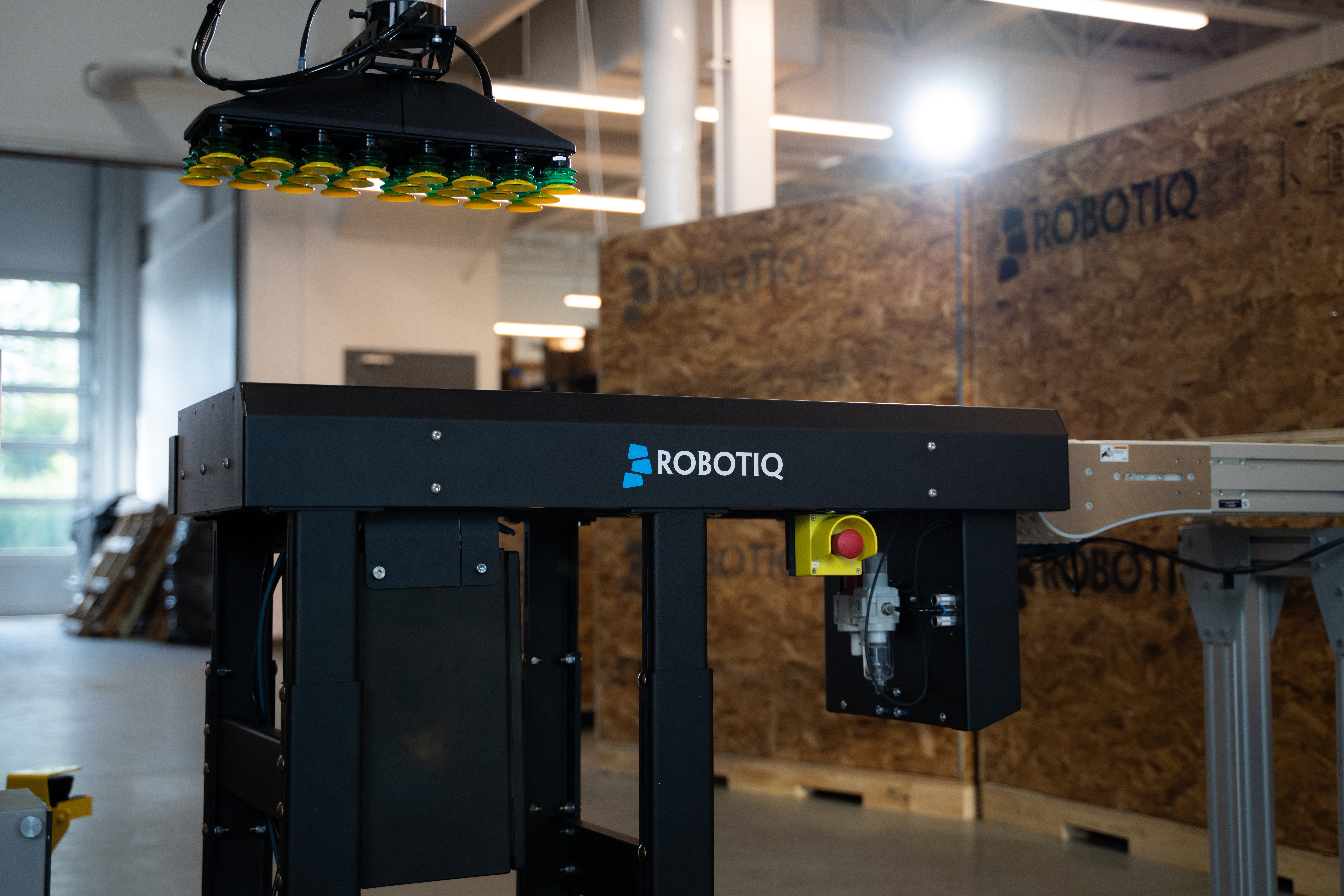Pallets + Robots = a Competitive Advantage?

Posted on Apr 18, 2017 in Palletizing
6 min read time
Palletizing is a trending application for collaborative robots. Could it give a competitive edge to your business? We look at the history of pallets and their importance for modern logistics.
Over on the DoF forum recently, user Robocase asked the community for help using a UR5 to unpack a pallet. This is one of many discussions on the forum regarding pallets, palletizing and depalletizing.
Packaging is one of top applications for collaborative robots. Unsurprisingly, pallets are a huge part of this. Many small businesses send and receive goods on pallets. The job of loading and unloading is repetitive, boring and ergonomically risky. Robots are an obvious solution.
In this article, we investigate the importance of pallets and the potential for robotic palletization to give your business a competitive advantage.
Pallets: A History of Automation
Pallets have revolutionized global logistics. Since the 1920's they have played a significant role in the world economy. They have had huge impacts on product design, from IKEA mugs to children's books. It's common for products to be redesigned to fit more units onto one pallet.
But where did pallets come from? When did they intersect with robotic technology? Why are they so vital for logistics?
Before Pallets There Were Skids
For centuries, the main ways to ship products were boxes, barrels and crates. These still have their place in logistics, but they have been overtaken by pallets. It is much harder to transport a barrel, for example, then stack it and quickly move it around the warehouse. With pallets it is simple.
The precursors to pallets were "skids," which date back to Ancient Egypt. They are similar to pallets but without a bottom deck. This subtle difference means that they can be dragged around but not lifted and stacked. These days, they are generally used as freestanding platforms.
Pallets and Forklifts
Pallets were born around the 1920's, coinciding with the invention of the forklift truck. This was no coincidence. Forklifts suddenly provided a way to transport heavy loads around the warehouse. Pallets made it quick and easy to lift high volumes of product and stack them on top of each other.
It is clear that mechanized technology and pallets have worked together from the very beginning.
Mechanical Palletizers
Up until the 1950s, pallets were still loaded manually. When mechanical palletizers finally came on the scene, humans hands were suddenly freed from the repetitive, physical work of loading and unloading. Mechanical palletizers also had the benefit that they produced more uniform palletizing, which made it less likely for the products to move during shipping.
The only drawback with these machines was that they required products to be practically identical. This was suitable for bulk distribution, but not very flexible.

Robotic Palletization
When industrial robots appeared, it wasn't long until they were being used for palletizing. The first robotic palletizer was introduced by Fuji Yusoki Kogyo in 1963. This was two years after the launch of the first industrial robot, Unimate.
Suddenly, palletization could be as almost as flexible as a human worker.
Robots palletizers had many advantages over their mechanical predecessors:
- They are inherently reprogrammable.
- They often take up less space.
- They can easily handle many different product types.
- They can do mixed-case palletizing.
This last advantage has become increasingly important in the modern world. As more small businesses have flourished, it has become common for suppliers to receive mixed orders rather than bulk orders of the same product.
Collaborative Robots
With the rise of collaborative robots, the transition from human hands to robot hands is complete. Unlike previous robot palletizers, which used large industrial robots, collaborative robots are accessible to even the smallest of businesses.
Cobot Palletization for Distribution and Logistics
Pallets themselves are now ubiquitous, but it's now especially important how you handle them. Businesses can differentiate themselves by improving the palletization and depalletization of products from these pallets.
Robotic packaging and distribution is becoming increasingly important thanks to the popularity of ecommerce and distributed supply chains. Small businesses need to be able to scale their order fulfillment quickly without incurring extra expenses or introducing delays in the orders.
Currently, only 20% of logistics warehouses use automation, according to a Dutch supply chain firm. However, this looks likely to increase. A recent DHL trend report showed that robot usage in logistics is rising. It suggested that cobots are more effective than non-collaborative robots when it comes to the needs of logistics.
The Warehouse as a Competitive Advantage
 Distribution of products can be a deciding factor in the scalability of a business. Warehousing has the potential to provide a competitive advantage to those businesses that can use it effectively, and robotics is becoming a key tool for doing that.
Distribution of products can be a deciding factor in the scalability of a business. Warehousing has the potential to provide a competitive advantage to those businesses that can use it effectively, and robotics is becoming a key tool for doing that.
In an article from Food Logistics, supply chain consultant Tony Vercillo explained why automation can help businesses to thrive in the modern climate:
"The trick to warehousing is eliminating human touches. Every time a human touches a pallet or a case, an expense occurs. Technology should be used to reduce the number of touches and steps within the warehouse process."
Collaborative robot palletizing can bring these advantages within the reach of small businesses. We don't all need to have fully-automated warehouses like Amazon does to benefit from automated packaging.
How to Get Started With Palletizing Cobots
It is very straightforward to start using collaborative robots for palletizing and depalletizing. A palletizing wizard allows you to easily program the operation by entering just two to eight points, depending on whether you want 2D or 3D palletization.
Our previous article and how to video show the exact steps to program a UR robot to load or unload a pallet.
If you need any further help, you can always ask a question to the community on DoF, just as user Robocase did.
Pallets + Robots could mean a competitive advantage for your business.
How will you use them together?
You can start to increase your competitiveness with the palletizing solution and take advantage of cobots.
Have you considered using robots for palletizing? What sort of products do you use which arrive on pallets? What is the top palletizing issue that the DoF community can help you with? Tell us in the comments below or join the discussion on LinkedIn, Twitter, Facebook or the DoF professional robotics community.



-modified.png)


-2.jpg)

Leave a comment